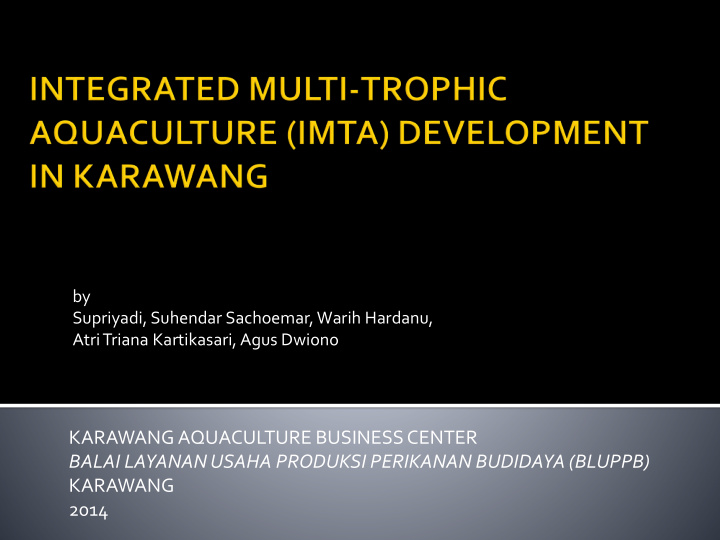



by Supriyadi, Suhendar Sachoemar, Warih Hardanu, AtriTriana Kartikasari, Agus Dwiono KARAWANG AQUACULTURE BUSINESS CENTER BALAI LAYANAN USAHA PRODUKSI PERIKANAN BUDIDAYA (BLUPPB) KARAWANG 2014
The development of marine and fisheries sector required a strategic and innovative policies through an effective breakthrough Aquaculture is still the key to the development of marine and fisheries sector Future aquaculture development should focus on the environmental and economic sustainability
▪ Principle Recycling waste generated by the cultivation of the main species (fish) into a source of energy and nutrients for the cultivation of other commodities, resulting in a product that can be harvested, and can reduce environmental impact ▪ Concept Combining the cultivation of some species from different tropic levels: fishes, seaweeds and oysters (Troell et al., 2009).
▪ Effectiveness of the utilization of nutrient cycling ▪ Increase of productivity ▪ Decrease of negative impacts on the environment sumber: http://www.jircas.affrc.go.jp/english/program/images/ proC-6a.gif
Total area of 400 ha
Each pond extent of 4.000 m 2 A.II- 4: Shrimp + seaweed + oyster A.II- 6: Shrimp monoculture A.II- 8:Tilapia + seaweed + oyster A.II- 10:Tilapia monoculture Shrimp: L. vannamei Seaweed: Gracillaria sp. Oyster: Anadara sp. Reservoir 2 Reservoir 1 A.II- 4 A.II- 6 A.II- 8 A.II- 10
Pond address Commodity Volume Shrimp ( L. Vannamei ) 30.000 seeds A.II-o4 (IMTA) Shell ( Anadara sp .) 119 kg Seaweed ( Gracillaria sp .) 500 kg A.II-06 Shrimp ( L. Vannamei ) 30.000 seeds (Monoculture)
Severe White Spot infection Moderate White Spot infection
NH 4 -N NO 2 /NO 3 -N N in grams N in grams 1.200 0.070 1.000 0.060 0.050 0.800 0.040 0.600 0.030 IMTA IMTA 0.400 0.020 Shrimp Shrimp 0.200 0.010 0.000 0.000 08-12 08-19 08-26 09-02 09-09 09-16 08-12 08-19 08-26 09-02 09-09 09-16 PO 4 -P P in grams 0.250 0.200 0.150 IMTA 0.100 Shrimp 0.050 0.000 08-12 08-19 08-26 09-02 09-09 09-16
Pond address Commodity Volume Tilapia Salina 15.000 seeds A.II-o8 (IMTA) Shell ( Anadara sp .) 90 kg Seaweed ( Gracillaria sp .) 500 kg A.II-10 Tilapia 15.000 seeds (Monoculture)
0.000 0.500 2.000 1.000 1.500 08-12 08-19 08-26 09-02 09-09 NO 2 /NO 3 -N 09-16 09-23 0.000 0.050 0.200 0.250 0.100 0.150 09-30 10-07 08-12 10-14 08-19 10-21 08-26 10-28 09-02 09-09 Tilapia IMTA 09-16 PO 4 -P 09-23 09-30 10-07 0.000 0.100 0.200 0.300 0.400 0.500 10-14 10-21 08-12 10-28 08-19 08-26 Tilapia IMTA 09-02 09-09 09-16 NH 4 -N 09-23 09-30 10-07 10-14 10-21 10-28 Tilapia IMTA
Production Commodity IMTA Monoculture Shrimp (kg/unit) 53 50 Shrimp size (gram) 20 8 Seaweed (kg/unit) 761 - Shell (kg/unit) 119 - Tilapia Salina (kg/unit) 700 550 Seaweed (kg/unit) 266 - Shell (kg/unit) 90 -
Application of IMTA in semi-intensive/ intensive aquaculture Determining system running properly before stocking shrimp/fish in IMTA model. Development of IMTA which is integrated with the site plan
Recommend
More recommend